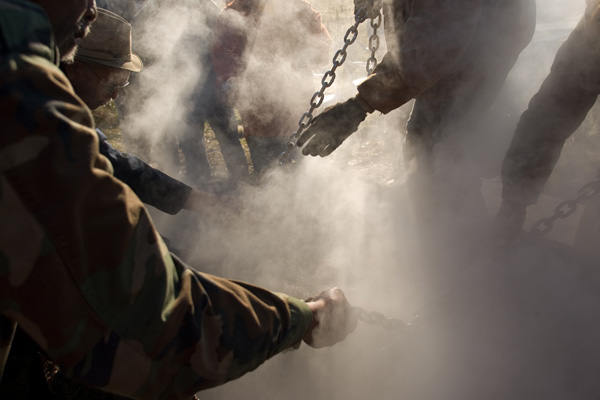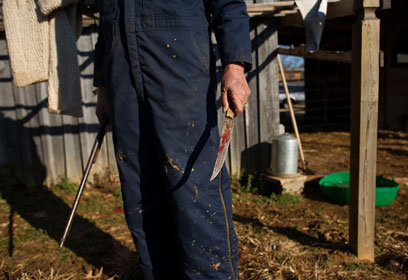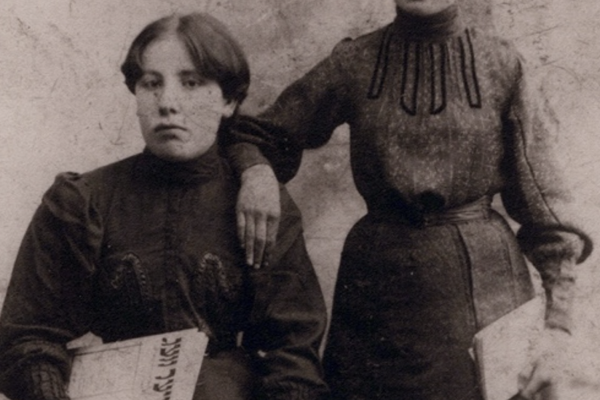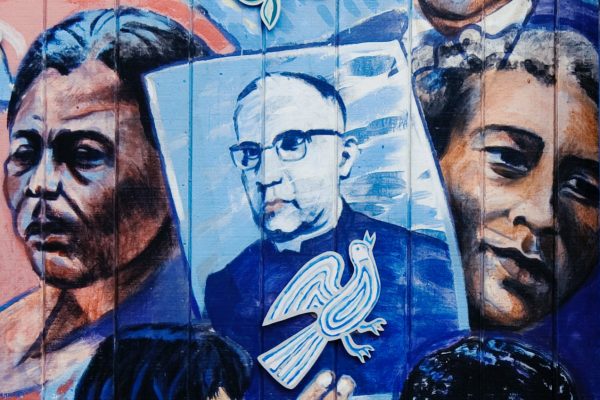Through the fogged window of his brown pickup, I could see only Mr. Elwood Whitmore’s short-brimmed black fedora as he pulled up beside the kitchen porch on a crisp December morning. Tahz and I put down our coffees, threw our jackets over our sleepwear, and popped outside, curious to meet this man who had come by on a lazy Saturday. Silver exhaust billowed in the breezeless morning air as the truck rumbled on the gravel driveway. He rolled down his window, revealing two feathers, one red and one green, sewn into his dark hatband. His eyes were hidden behind small dark glasses. “I was told someone over here needed some help killing their hogs,” he offered softly.
We brought Mr. Whitmore down to see our pigs. Old but steady, his mind seemed, clear and kind. At ease, looking around in his blue mechanic’s jumpsuit, he quietly took in the situation: our pigs, their pen, the cabins, the fields. He leaned in on the metal gate. The pigs came up to him inquisitively. He evaluated them with calm detachment. “They’re not ready to kill,” he said, almost to himself. “Too small. Give ’em three more months,” he proposed. “Then they’ll be ready.”
Tahz and I winced. That wasn’t what we had in mind. We knew they were on the small side, but we were determined to get this done before we headed back to our homes for Christmas. For my part, I was done being a pig farmer. I had had my education and I was tired of it. Tired of the work of feeding, the stress of confining, the worry of mistreatment. Tired of the responsibility. We needed to finish this and move on.
“Been feeding them corn?” he asked.
“Yep,” Tahz answered confidently, “for the last few weeks or so.”
Mr. Whitmore somehow nodded and shook his head at the same time. “Should have been feeding ’em corn since . . . .” He calculated. “August. Then they’d be a good size by now.” He paused. “We used to grow ’em up to 300 pounds before we’d kill ’em.” The faint ambrosia of old days wafted past. He shook his head. “These ones here are too small.”
Mr. Whitmore had come up during the times when everyone around those parts raised a few hogs. He cast his gaze to the distant tree line, then down at his boots. “Practically no one does anymore.” He looked up, perhaps wondering about us.
“Do you have a gun?” Tahz asked, steering us to practicalities.
“For these little pigs?” Mr. Whitmore glanced back at the animals still snorting beside him at the fence. “You don’t need a gun for them,” he nodded toward them and cracked a smile. “You could probably just choke ’em,” he chuckled, grabbing the air solidly with his hands. We smiled and shuffled our feet, embarrassed, and explained our situation.
“Yeah, I’ve got a gun,” he nodded.
“And so, ’m, well . . . you think you can help us?”
“Yep,” he nodded kindly and looked back toward the trees. “I can help.”
He got into his truck. “Come by next week sometime,” he said through the window. “I’ll show you what you’re gonna need to kill those pigs.”
The March prior, Kevin and I had gotten up early to drive down past Salisbury and pick up the piglets. The guy selling them raised a few each year for meat, then sold most of the litter to cover his costs. He snapped on a pair of latex gloves as he stepped over the fence and into the pen he’d created right in his front yard. Unhooking, bending, and then refastening a section of fence, he corralled three six-week-old piglets into a corner, picked them up by their hind legs, and passed them over to us. Our bare hands grabbed their bristly legs, their unfamiliar coats of rusty red hair. We pushed them, squealing, into a borrowed cage in the back of our truck.
His daughter had slipped out of the house to watch, distant and passively defiant.
“Is it sad when people come and take away your pigs?” I asked, trying to connect. She nodded very slightly but didn’t look up—her eyes fixed on the piglets.
Her dad laughed. “You don’t miss them when they’re big, though, do you?” She stared more determinedly, but also, it seemed, not fully reckoning the difference between the piglets she loved and the beasts they grew up to be.
“Well, thank you for letting us take them,” I said to her. “We’re gonna be really good to them and they’re gonna have a really good life in a really nice place.” She stared flatly into the pen as the remaining piglets huddled together by their mother. “If you two are ever over in our parts, come by and visit.” She glanced at me caustically and reached for her father’s hand. We paid him eighty dollars, shook hands, and headed home.
We trained the piglets to avoid the electric fence by keeping them for a week in a small pen encircled by a hot wire. In that short time, the rhythm of snap and squeal became as familiar as birdsong in the trees.
As they grew, their bodies became less sensitive to the shock, and we had to keep adding strands of fencing and increasing the voltage. We started with an eco-friendly solar-powered system, but within a few months we invested in a fence whose jolt could run two miles and was used for confining buffalo and large cats.
‘Jesus!’ I thought, throwing the empty bucket at her, ‘I am gonna have no fucking problem killing you.’
Once a week Tahz picked up whey for the pigs from a local cheesemaker. They went bonkers for it. As soon as they heard the handles clanking on the sides of the plastic buckets, they’d blast out of their shed, shoving one another, grunting, snorting, and salivating as they stormed toward the electric wire. When we poured the whey, they dove ferociously into their buckets, violently slurping until their heaving bodies finally relaxed into a milky stupor. Then, they would wander drunkenly around their pen for a while, carelessly interested in any stump of a thing that might also be food, before finally lying down, exhausted, in the shade.
A few months into our experiment, another friend, Justin, came by to add a new, younger piglet into the mix. Excluded from the start, she was rarely given a chance to eat anything but half-chewed scraps of food and the dirty muck of leftover whey. One sow was especially aggressive, biting her and attacking us whenever we brought food around. To get her to back off, we had to give her a solid kick in the head—a kind of violence that was uncomfortable at first but quickly became thoughtless. One morning, as I was pouring their whey, she jumped up and knocked the bucket loose from my grip, drenching me from head to toe in the warm, sour, milky mess. “Jesus!” I thought, throwing the empty bucket at her awkwardly, “I am gonna have no fucking problem killing you.” I recoiled from myself inwardly, shocked at the moral repugnance of the impulse, of a willingness to kill for something as trivial as a bad personality.
Even from our zoo-grade fence, they found ways of escaping. If left uncut, grass would eventually ground the wire, disabling it. Sometimes the pigs would just burrow under a post deep enough to squeeze through to freedom. One summer evening Tahz ran up to the kitchen and panted desperately, “They’re out again.” We couldn’t believe it. It was getting dark. He quickly drilled to the essence of our predicament. “It boils down to this: we are holding these animals against their will. They want to escape. We want them to stay put. They’re strong and they’re willful and if we want them to stay, our will must be stronger. That’s just what it comes down to. We need to be more aggressive than them.” He was right.
When we got down to the barn, the animals, frenzied with freedom, were charging through the open fields. It was humorous in a way, but also frightening. Their hunger was always extreme and they were so powerful that they could easily hurt someone.
Our pig-raising experiment was playing out in Mebane, North Carolina at an activists’ spiritual retreat center called the Stone House, where Tahz and I lived and worked. That particular evening, a small band of community organizers visiting from faraway cities caught wind of the excitement going down by the pen and gathered as amused spectators to our country antics. With their arms draped over the fence and wine glasses sloshing, they merrily cheered us on as we scrambled to lure our pigs into an empty horse stall. When we finally corralled them, we drilled planks over the opening to prevent their escape. The crowd laughed. We laughed, too. We laughed at the absurdity of the situation, at the depths of our own desperation, at the Tom-and-Jerry humor of blundering violence.
Our relief in the pigs’ confinement dulled the disquiet that would have motivated us to find an immediate solution, so for two weeks the four pigs wallowed in that stall—a mess of feces, urine, food, and water—as we gave ourselves a break. We felt ashamed, but we had no other options and many other responsibilities: work lives that went well beyond raising pigs. When we finally repaired the fence and let them out, the pigs were pale and bewildered, beleaguered and broken. It was an ethical embarrassment but we had needed a reprieve.
We were meat eaters who had never taken personal responsibility for the fact that eating meat means killing. We had tried to be responsible consumers of meat as a commodity by buying the flesh of humanely raised animals, but we had never borne the personal burden of consuming meat as a being, of killing to eat, and we felt there was something deep and undeniable, even inexcusable, about this contradiction. My body and mind need some meat to function properly. I didn’t want to convince myself that killing for food was ethical by reading, arguing, or philosophizing. I felt that I needed to know if it could feel ethical, feel sacred, in my heart.
But in our endeavoring to raise meat animals ethically, I realized we were capable—through laziness, ignorance, circumstance, or spite—of creating real suffering long before any killing happened. This project was intended to unify our values of spirit, justice, culture, and sustainability into a coherent and ethical way of being in the world. Instead, it shocked the central nerve of our work until the body and the spirit, the land and the vision, the practical and the principled felt inexorably pitted against each other.
My confidence in our ability to continue righteously was weakened. In my dreams, I was gnawed at by a grinding sense of irresponsibility. One night, awakening panicked in the darkness, I was struck with the knowing, like a blast of thunder in my heart, that while there are important differences between the horrors of industrial factory farming and what we were trying to do, no animal wants to be confined. No animal wants to die.

The body of a hog is immersed in 145-degree water to help loosen the hair before butchering. Photograph: D. L. Anderson
In some ways it should have been an easy decision for me. I am a Buddhist and in Buddhism, killing and morality are irreconcilable. The karmic weight of intentionally killing another living being is considered overwhelmingly horrendous. This doesn’t mean that Buddhists—even monks and nuns—are necessarily vegetarians. The Buddha instructed his monastic disciples to accept whatever food was offered to them, these donations being their only way of sustaining themselves. In Tibet, where many Buddhist monastics and laity eat meat, Muslims are frequently employed in the work of butchering so that Buddhists won’t be tainted with the karma of killing. Monks in Southeast Asia can eat meat as long as they don’t suspect that the animal was killed specifically for them. In Japan, there was for generations a caste of people, called the Burakumin, employed for all tasks karmically vile. With some notable exceptions, a pervasive notion across the Buddhist world is that eating meat is okay so long as you’re a few steps removed from the process, from responsibility.
I explained this moral calculus to a friend, Quince, who was raised in a hunting culture in northern Wisconsin. When I finished, he looked up and paused with perplexity. “Well, that’s just, like, totally retarded. It’s the exact opposite of my perspective,” which valued taking personal responsibility for killing as part of his omnivorous food ethic.
I asked a teacher of mine, a Burmese Buddhist monk living in North Carolina, if the Buddha ever considered it acceptable for householders to kill anything at all, even vermin or pests. He looked at me aghast. “No,” he said sternly, apparently bewildered by my ignorance. “Buddha said it is never tolerable to kill.” It seemed as if he were watching the religion’s most basic teachings disintegrating in the West before his eyes. “Never,” he repeated and looked at me as if trying to see if this utterly simple concept had made it through my thick skull. “Of course,” he added after a pause, “the Buddha was perfect,” and he smiled sympathetically.
The night before the slaughter, a group of us gathered in the kitchen. We sat around talking, drinking wine, preparing. We made rabbit stew, greens, and cornbread. After dark, with votives in jelly jars, a few bowls of homegrown corn, a drum, and a fiddle, we made a quiet procession down to the pigs to offer them a final meal. As they ate, we listened reverently to Justin’s fiddle. We petted them and cried. We returned to the house and quietly parted ways, everyone heading to bed for a few short hours before the long day ahead.
At 4:00 a.m., when I got to the barn with coffee for everyone, the fire was just getting started. It was dark and cold but there was an aliveness in the air, a nervous optimism. Our breath billowed as we joked and laughed and warmed our hands by the fire. A thick frost had covered the fields.
As the sky brightened, I took a break from setting up and sat on the porch of a nearby cabin. A wave of fear, sadness, and doubt came over me. Even though forty people would be there within a few hours, I knew I could probably put a stop to the whole thing if I wanted. But my flickering opposition wilted as I reckoned with and surrendered to the momentum of choices already made. There was a lot of work to do so I took a deep breath and moved back into the day’s tasks.
One night, awakening panicked in the darkness, I was struck with the knowing that no animal wants to die.
By 9:00 a.m. the scalding water was at 150 degrees. Guests had started to trickle down from the main house. At the very moment we were ready, Mr. Whitmore arrived, driving slowly up to the barn in his truck. He rolled down the window and smiled. He was in good spirits. Still wearing his hat and jumpsuit, he had added a selection of beautiful silver rings to his hands, one with a giant turquoise nugget. He got out of his truck slowly and walked over to where we were all waiting. “I’d’ve thought you’d’ve had ’em in the water by now,” he playfully prodded the group as we groaned and laughed.
He walked over to the vat to check the water. “Cool it down a little,” he said gently. “That’s too hot. It’s got to be at 145.” We raked coals from the fire and started hosing in fresh water. He inspected the tripod that the pigs would hang from to be dressed and the plywood tables on which much of the butchering would be performed. He was satisfied. He walked straight toward the pen.
“Okay, who’s the shooter?” he asked loudly. A chasm of silence responded. Then, nervous laughter. He nodded, went back to his truck to get out his rifle, a simple .22, and loaded it.
Mr. Whitmore stepped into the pen and the pigs came up to him, curious and quiet, in awe-striking innocence. He looked at one, creased his arm, and lifted the barrel of the rifle to her forehead. His firm hand opened a finger to the trigger and squeezed a muffled pop from the gun. A puff of smoke and the pig crumpled gently into the dirt. Blood poured quietly onto the dry ground. There was the drifting smell of something burnt.
He asked for his knife, an old steel blade with a carved wooden handle. Moving toward the pig, he quickly jabbed the knife into her throat. Blood spurted out in pulses as the body gently rocked and convulsed, the final waves of electricity coursing through it. Then there was stillness. We all bore witness to the calm quiet that pervaded.
“Okay, let’s bring her to the tub,” he said.
We grabbed her legs and carried the heavy body to the vat of hot water that would loosen the skin from the animal. Chains were laid across the tub and the pig was lowered in. Mr. Whitmore directed us to pass the chains back and forth in a way that would turn the body. Then, with the help of a plank, we pulled it out of the vat.
“Okay, start scraping,” he said. Several of us heaved the carcass onto a plywood workstation, picked through a strange assembly of metal scrapers, and started scouring skin and hair from the body. Working quickly was impossible. The body defied our desecration, especially in the folds around the face, armpits, and groin. Perhaps it was our own tenderness that resisted the violence to these sensitive places. Slowly, below the layer of spiny fur and grayish grime, a white clammy surface began to emerge. I recognized it immediately in flashing memories of grocery stores and my mother’s kitchen: it was pork. Expanding patches of it were revealed amidst the broader landscape of what I still recognized as the pig and slowly, inexplicably, this massive thing before me, though hardly changed, was transformed.
We hoisted the carcass and tied it upside-down onto a tripod made of two-by-fours. Mr. Whitmore took another knife and, with a single confident stroke, carefully drew a line around the tail and down the front of the pig, stopping at the neck. The cavern of the body blossomed open as if a zipper had been pulled down the belly, releasing a mass of innards with a soft plop into a bucket he had placed on the ground below it. He swiftly cut off the head and set it aside. Bringing the carcass back to the worktable, he delicately tapped an axe along the spine. It pulled out gently from its cavity and was set aside in another bucket. A handsaw, some more knives, and a gaggle of open-eyed apprentices went to work separating pieces from one another. While we worked, Mr. Whitmore went back into the pen to pick the second of three pigs we would slaughter that day.
The bright sun had not yet burned the chill from the morning air, but a heat had built within us. Once the intimate moments of killing retreated to memory, the group settled into a hum of work and playfulness, swaying between gawks at the grossness and the tedious practicality of butchering. One couple cleaned the chitterlings. Another woman was preparing a head to boil down into head cheese. She laughed and posed for pictures with friends. The cheesemaker who had donated the weekly whey sat at a table cutting meat from fat for sausages and told her companions stories about recipes and family traditions. I found myself trying to trace the invisible trails between the breath-clenching intensity of killing and the calm cheerfulness that now pervaded our group of families, friends, local farmers and foodies, respected activist elders, children, writers, and a newspaper reporter who were gathered together.
It seemed like Justin’s entire family was there, coming from South Carolina and as far away as Detroit. His mom and sisters kept the kitchen warm and jovial while preparing a feast for lunch. Tahz’s parents came up from Atlanta. Men whose families had lived for generations in Mebane gathered in the shed to advise us on techniques for salting the hams. Folks ran to the store to pick up last-minute “supplies.” Plenty of people just lounged around and relaxed, enjoying themselves and each other’s company on a warming December afternoon.
Not far away, at the Tar Heel plant of Smithfield Foods, five thousand workers killed thirty-two thousand hogs every day in miserable conditions. Blowtorches and huge industrial machines, fluorescent lights, chemical tubs, and lakes of toxic excrement dominate the atmosphere. Companywide, Smithfield “processes” twenty-seven million hogs a year. Compared to that, we were feeling pretty good about ourselves. No one there had been to anything quite like our hog-killing, with such a diversity of people coming together for the sake of community, culture, tradition, learning, and understanding.
We cooked some tenderloin for everyone to share. It was flavorful but profoundly chewy. “Almost too fresh,” Justin opined. We winced, swallowed, and agreed. The first bites of our pigs. Halfway through the meal, one of our refrigerators shuddered dramatically and died. The warm bodies of two entire pigs were too much for it. The blood and personality were gone but the heat of life remained, asserting itself.
By 4:30 in the afternoon we were bleary-eyed. The hams were in the garage salting, draining blood in wooden boxes, where they would stay for weeks before we hung them to cure for many more months. The sausage trimmings were ready for the next day’s trip to the meat processor, where they would be encased. One family took the chitterlings, another couple took the heads. Gifts were given. The group dispersed. We cleaned up and crumpled into the blankness of sleep.
A few weeks after the killing, I brought home a pork shoulder to prepare my chancho hornado for Christmas Eve, a family tradition. Cutting shallow slits around the meat, my clumsy fingers stuffing them with garlic, herbs, and lime juice, swells of appreciation, shame, resignation, and pride moved through me. It was a barbarous sacrament, and yet a visceral sense of the value, the primal worthiness, of meat reverberated within me. I handled the cold body, the beauty and burden of incarnation, the stuff of being that mattered, aware that the mind and spirit—the ethereal genius—was lost. Yet in the preparation, I felt intimately closer to an understanding of life and culture, to community and my place on this earth, than ever before. It was nearly overwhelming.
In this moment of connection, my heart was confronted with an undeniable paradox: the experience felt sacred but it still didn’t feel ethical. It had never occurred to me that these two things might be separate, that the moral quality of our actions might have little to do with our spiritual sense of interconnectedness to “life,” to our place in the cosmos, to culture. Standing there, I had a shimmering feeling that our ethical sensitivity might actually be the thing which most beautifully and painfully magnifies the distance between ourselves and nature, while our reverence toward the sacred strengthens our bond to the unfathomable cycles of existence (to what the Buddha called sa⋅msāra). Maybe sa⋅msāra is another word for sacred. But our commitment to the ethical might give us a footing from which to transcend those cycles.
The fourth pig, the runt, was too small to kill that day in December. We decided to continue to take care of her until she was big enough to make our investment of time, money, and energy worthwhile.
For weeks she lay in the grass, despondent and immobile. When we brought food, she hid in the corner of her pen. She scurried away when we approached. We didn’t even try to get her back behind the electric fence. It seemed best to just leave her alone. We had betrayed her companions. We would betray her.
Time passed, and she slowly perked back up. She regained her appetite and seemed to appreciate the lack of competition for food and shelter. We opened up her pen to a larger piece of the pasture and brought her some fresh hay for bedding. After a brief conversation about our options, we decided to bring her up to a small family-owned slaughterhouse in Caswell County where we could pay them to do the butchering for us. None of us was up for it ourselves. Toward the end of June, I borrowed an animal trailer from another farmer to drive her up.
The night before we took the trip, Kevin and I spent an hour trying to get her into the trailer. Not having fed her all day, we poured a half-bucket of cracked corn into the trailer and hoped she’d just follow her hunger to the food. It seemed she could tell that something about the situation was unpromising, so she managed to escape our clumsy trap by muscling under a wire fence in the barn. As she trotted her final romp around the pasture, it looked something like an expression of real freedom. But we knew the forces at play, the deeper truth, so we watched her lazily, unconcerned. She tried to keep away from the trailer, but we knew, in the end, that she couldn’t resist the corn. Eventually she abandoned what she feared for the sake of what she craved. Betrayed by her own nature. In a way, it was reassuring. We were humans. She was a pig. We were playing our parts. But I wondered too if I hadn’t also betrayed myself in this process: overcoming the moral fear of killing with the more powerful force of craving.
The next morning I came to rinse her and the soiled trailer with the hose before we took off. I talked to her a bit. She lay on the trailer floor and stared off at something that wasn’t there, seeming to reckon the dark depths of her situation. Before I put the hose to her, I noticed tears coming from her eyes down her snout. Do pigs cry? I have no idea. But the impact was the same. A breeze of doubt followed a thumbprint of dissonance on my heart. I acknowledged them, got in the truck, and started my drive north.
The slaughterhouse was no Smithfield but it was also no Stone House. There were no aunties laughing and cooking in the kitchen, no uncles sneaking off to the liquor store. There were no ceremonies, no Zen butchers, no students, no community. There were me and my pig and a small staff of friendly-enough guys who were there doing their jobs.
They maneuvered our pig into a wooden pen and slapped a sticker on her red coat with a barcode and the number 7975. Three cows beside me were mooing and lamenting the confines of their temporary cell. Our pig was prodded out of her pen, up a walkway, and through the slaughterhouse door, which shut behind her. A man came out and yelled down to me that I could come in and watch if I wanted. I followed him inside to a platform above the killing floor as he grabbed a rifle from the wall. Our pig stood below in a small iron pen. He walked down the steps, aimed the barrel through the bars of the pen, shot our pig, and killed her.
She was stiff but her body vibrated intensely. One wall of the pen was raised and she dropped, frozen, on her side. Another man wrapped a chain around her foot and hoisted her into the air with the long press of a button on the wall. He stabbed her jugular with a spear, and the rhythmic bleeding and pulsating of her body, which was now familiar to me, followed. Another button moved the chain that carried her to an automated scalding machine where she was dropped in, coming out nearly hairless a few moments later. The work that took twenty of us several hours that morning in December hadn’t taken these men ten minutes. They hung her back up on the chain and passed a blowtorch over her to singe off any remaining hairs.
With my pig progressing down the line, the cows were led through the door and into the pen, one at a time. Blasts from the gun were followed by the sounds of motors lifting gates, of cranks and pulleys lifting bodies. The animals twitched and writhed in the air as blood gushed from them like rivers from their headwaters. I noticed the deepening smell of burnt hair and started to feel faint.
My pig was at the far end of the room and was being split in two by an enormous band saw hanging in the air. A cow beside me was having its head removed. The manager came up to me amid the clanking, the buzzing, and the bleeding and asked enthusiastically, “So, what do ya think?”
This is what it means to eat meat, I thought to myself. It is horrible. The acknowledgment struck quickly, though, and within moments I felt myself relax. There, on the concrete floor, amidst the sights and sounds of killing, I settled into the solid presence of my body, as my heart filled mysteriously, and perhaps unforgivably, with peace.








